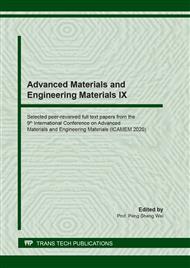[1]
Y.H. Zhao, et al. Enhanced mechanical properties in ultrafine grained 7075 Al alloy, Journal of Materials Research, 20(2)(2011) 288-291.
Google Scholar
[2]
D. Vojtech, E. Tagiev, et al. Casting properties of the high-strength AlZnMgCuNiSi alloys, Journal of Materials Research, 18 (3) (2003) 635-641.
DOI: 10.1557/jmr.2003.0083
Google Scholar
[3]
J.P. Immarigon, et al. Lightweight materials for aircraft applications, Materials Characterization, 35 (1) (1995) 41-46.
Google Scholar
[4]
J.C. Williams, et al. Progress in structural materials for aerospace systems, Acta Materialia. 2003, 51 (19) (2003) 5775-5799.
Google Scholar
[5]
A. Heinz, et al. Recent development in aluminum alloys for aero-space applications, Materials Science & Engineering A, 280 (1) (2000) 102-107.
Google Scholar
[6]
W.S. Miller, et al. Recent development in aluminum alloys for the automotive industry, Materials Science & Engineering A, 280 (1) (2000) 37-49.
Google Scholar
[7]
B. Liu, et al. Recent development and prospects for giant plane aluminum alloys, Chinese Journal of Nonferrous Metals, 20 (9) (2010) 1705-1715.
Google Scholar
[8]
Heat Treating of Aluminum Alloys, ASM Handbook: Heat Treating, ASM International, Metals Park, OH, 1995, pp.841-879.
Google Scholar
[9]
I.J. Polmear, Light Alloys: Metallurgy of the Light Metals, Arnold, London. (1995).
Google Scholar
[10]
U.S. Department of Defense, 2003, Metallic Materials and Elements for Aerospace Vehicle Structures,, Document No. MIL-HDBK-5J.
Google Scholar
[11]
W. Cassada, et al. Aluminum Alloys for Aircraft Structures , Advanced Materials and Processes, 160 (12)(2002) 27-29.
Google Scholar
[12]
J.S. Robinson, et al. Reducing Residual Stress in 7050 Aluminum Alloy Die Forgings by Heat Treatment, Journal of Engineering Materials and Technology, 130 (3)(2008) 635-644.
DOI: 10.1115/1.2931150
Google Scholar
[13]
J.K. Park, et al, Effect of Retrogression and Reaging Treatments on the Microstructure of Al-7075-T651, Metallurgical Transactions A, 16 (11) (1985) 2068-2068.
DOI: 10.1007/bf02662411
Google Scholar
[14]
Society of Automotive Engineers (SAE), 1992, Aluminum Alloy Die Forgings 6.2Zn-2.3Cu-2.2Mg-0.12Zr (7050-T74) Solution Heat Treated and Overaged,, Document No. AMS 4107D.
DOI: 10.4271/ams4107f
Google Scholar
[15]
B. Li, et al, Influence of heat treatment on the strength and fracture toughness of 7N01 aluminum alloy, Journal of Alloys and Compounds, 678(2016) 160-166.
DOI: 10.1016/j.jallcom.2016.03.228
Google Scholar
[16]
S.H. Wang, Research on Electromagnetic Casting and Strengthening and Toughening of High Strength Aluminum Alloy [D]. DaLian:Dalian University of Technology, (2009).
Google Scholar
[17]
P. Guyot, et al. Precipitation kinetics, mechanical strength and electrical conductivity of AlZnMgCu alloys[J]. Acta Materialia, 44 (1996) 4161-4167.
DOI: 10.1016/s1359-6454(96)00033-x
Google Scholar


